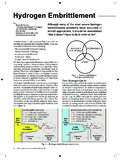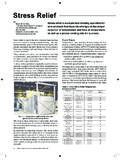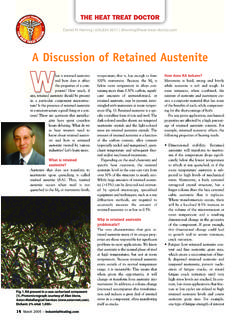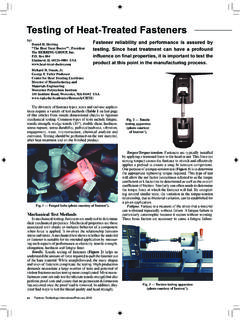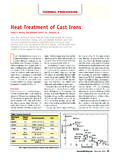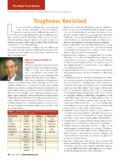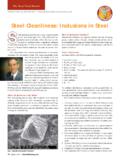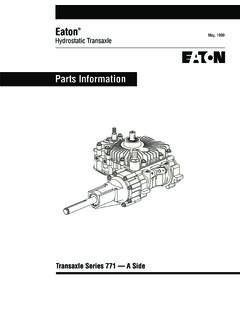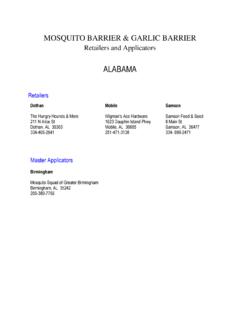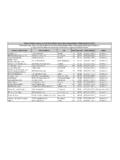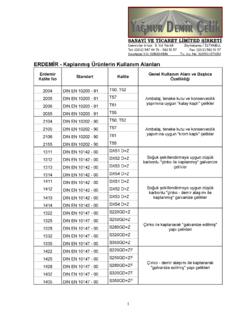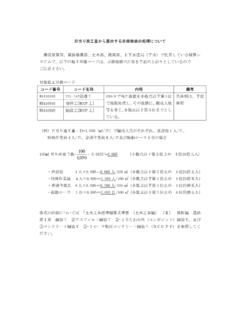Transcription of H Fundamentals of Heat Treating: Ideal Diameter
1 Quantitative measure of a steel s hardenability is expressed by itsDI, or Ideal Diameter , value. This abbreviation comes from theFrench phrase diam tre id al and refers to the largest diame-ter of steel bar that can be quenched to produce 50% marten-site in its center (Fig. 1). The quench rate of the bar is assumed to be infinite-ly fast on the outside; that is, it has sufficient quench severity so the heatremoval rate is controlled by the thermal diffusivity of the metal and not theheat transfer rate from the steel to the quenchant. Typically, water or brine pro-vides these infinitely fast quench conditions. The larger the Ideal diametervalue, the more hardenable is the values are an excellent means of comparing therelative hardenability of two materials as well as deter-mining if it is possible to harden a particular cross sec-tion (or ruling section) of a given steel.
2 DI values areinfluenced by the hardenability (chemical composi-tion) of a material, the grain size and the severity ofquench. It is important to note that hardness in steel isdetermined by carbon content while hardenability isdetermined by the alloy chemistry, which also includescarbon. Elements such as copper and vanadium play alarge role in hardenability. Also, a number of customers today are using boronas an inexpensive, yet effective element, to increase hardenability. Therefore,DI values vary greatly depending on material, from less than one inch (25 mm)for say an AISI 1045 steel to over of 7 in. (178 mm) for an AISI 4140 more hardenable steel allows the heat treater to form martensite even inthe middle of a thick bar (where cooling rates are slow), whereas a less harden-able steel can achieve a martensitic structure only in thin sections, where thecooling rates are fast.
3 Steels that form martensite in thicker sections are thosein which the nucleation and growth of ferrite and cementite is slow and can beavoided. Many solute additions slow down the formation of ferrite,as do larger grain sizes ( , ASTM 6 vs. ASTM 8) because fewergrain boundaries are present to act as ferrite nucleation , alloy additions and grain-coarsening steps are used tomake steel more DI values are calculated for cylindrical bars, the harden-ability of various product shapes can be estimated using DI valuesfor equivalent rounds; cooling rates are influenced by surface-to-volume ratios. The hardness of steel having varying amounts ofmartensite can then be determined by means of a Jominy harden-ability test.
4 Jominy data can also be used to estimate the quenchseverity necessary to produce a given hardness distribution in aparticular the Ideal diameterIdeal Diameter can be calculated fairly precisely if you know theaustenite grain size and alloying elements present in the steel ofinterest. ASTM Specification A255-02 (Standard Test Methodfor Determining Hardenability of Steel) assumes a grain size of 7in its calculation because, statistically, most steels are close to thisgrain size s calculate the DI value for a given steel with an ASTM grain size and a chemical composition of , , , , and The Ideal Diameter iscalculated using Equation (1) with individual values listed in Table1.
5 For elements other than carbon, locate the element percentagein the carbon column and then read across to find the alloy fac-tor under the appropriate element = DI Jominy fMn fSi fNi fCr fMo (Eq 1)Our calculation then becomesDI = = in. ( mm)Thus, it is not possible to harden a cylindrical cross section orequivalent round representing an actual shape greater than in.(53 mm) and still obtain at least 50% martensite in the core, nomatter what the quenchant is!Remember that the DI calculation is empirical. There aremany different DI equations with each giving slightly differentanswers so companies often use more than examplesA carburizing grade of steel was found to have low core hardnessafter final machining.
6 However, this low hardness condition affect-ed less than 20% of the thousands of parts manufactured. All of thematerial complied with the material specification for chemistry andJominy hardness at the J8 location. Analysis of DI values calculatedfrom the mill heat chemical composition for each batch predictedwhich batches were most likely to display low core hardness. A pro-cedure was then developed to check steel mill heat lots for the sub-THE HEAT TREAT DOCTORD aniel H. Herring | | rialH Fundamentals of Heat Treating: Ideal Diameter024681012145 2 1 valuesD1valuesFig. 1. Relationship between actual critical Diameter , or D (the largest size barthat, after being quenched in a given medium, contains greater than 50%martensite.)
7 And Ideal Diameter , or DI (size of bar hardened to 50% marten-site in a perfect quench medium) for determining the quench severity (H). Ina perfect quenchant, the surface of the bar is assumed to cool instantaneous-ly to the temperature of the quenching 2005 1 Alloy factors for calculating Ideal Diameter [4]% CBase Ideal Diameter (DI Jominy) for ASTM grain size No. shownAlloy factor (fx): x = elementNo. 6No. 7No. parts prior to purchase of raw material toassure that a minimum DI value is another example, a gear manufacturerfound it necessary to continually make sizeadjustments prior to carburizing in an attemptto control distortion and compensate for lot-to-lot material variation.
8 The steel, while meetingspecification requirements, was found to be atthe extremes of the control range. For thismaterial, typical H band steel at two points ofJominy control (J4 and J8) had a range of 12 to14 HRC from high to low. Even RH (restrict-ed hardenability) steel was found to have a 7 to8 HRC hardness difference at the J4 and J8positions. The solution was to specify DI valuesin a narrow control range, and the result waspredictable part growth after carburizing andthe elimination of a costly manufacturing do we go from here?Today, to better predict lot-to-lot distortion,manufacturers are specifying (and steelmakersare producing) material to extremely tight DIranges ( , to ) to ensure achieving sizecontrol on critical parts instead of trying tohold a tighter Jominy hardenability range.
9 Thisis especially the case if no post heat treat oper-ations will be performed. Ideal Diameter is aninvaluable tool in the heat treater s arsenal. IHBibliography Dale Weires, The Boeing Co., private correspondence Scott Hyde, The Timken Co., private correspondence Grossman, and Bain, ,Principles of HeatTreatment,ASM Intl., 1964 Totten, et. al., Limitations of the Use ofGrossman Quench Severity Factors, ASM Intl., 1997 ASM Hdbk, Vol 4: Heat Treating, ASM Intl., p 72-74,199120 September 2005 related information may befound by searching for these (and other)key words/terms via BNP Media LINX : Ideal Diameter ,critical Diameter , hardenability, Jominyhardenability test, quench Furnace SeminarOctober 17-20, 2005 For more information or to register, see us online or by calling (814) 332-8576PO Box 908 Meadville, PA 16335 (814) 332-8400 Fax: (814) 724-1407 Email: website: : $400 Topics Include:Aluminum Ingot PushersLog HomogenizersCoil/Foil/Rod AnnealingSolution Heat Treatment- Jet HeatingReverb Melting - SCRAP MANAGER See Us at Booth # 1341 Info # 20 or
